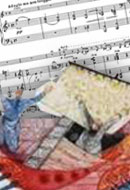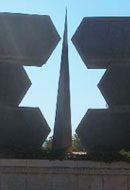Religious Life
 Diversity at Dura-Europos
Diversity at Dura-EuroposWednesday, October 12, 2011 by Alex Joffe | Jewish Ideas Daily » Daily Features
A new exhibit at New York University's Institute for the Study of the Ancient World brings to life the ancient city of Dura-Europos, which stands high above the Euphrates River on the eastern border of modern Syria, a monument to vanished eras.
 Muslims and Jews in America
Muslims and Jews in AmericaMonday, October 10, 2011 by Aryeh Tepper | Jewish Ideas Daily » Daily Features
Consider these two questions: During the past ten years, approximately 170 American Muslims have been arrested for plotting terror attacks against Jews or materially aiding other terrorists.
 All These Vows
All These VowsFriday, October 7, 2011 by Lawrence Grossman | Jewish Ideas Daily » Daily Features
No one knows for sure how Kol Nidrei originated. It is by far the best-known Yom Kippur prayer, but in fact it is neither a prayer nor actually recited on Yom Kippur. Rabbis have never liked it.
 Jonah and the Music of Yom Kippur
Jonah and the Music of Yom KippurThursday, October 6, 2011 by Michael Carasik | Jewish Ideas Daily » Daily Features
Leviticus 10 tells us that Aaron's sons Nadav and Avihu died for bringing "strange fire" before the Lord in the wilderness. As a result of their deaths, according to Leviticus 16, God instructed Moses to ordain an annual Day of Atonement.
 Pay to Pray?
Pay to Pray?Wednesday, September 28, 2011 by Jack Wertheimer | Jewish Ideas Daily » Daily Features
In the middle decades of the 20th century they were called "mushroom synagogues." They popped up in the waning days of summer to provide High Holiday services, then disappeared at the conclusion of Yom Kippur. Today, "mushroom synagogues" are once again in vogue—but with a critical difference.
 Desperately Seeking S’lihot
Desperately Seeking S’lihotFriday, September 23, 2011 by Allan Nadler | Jewish Ideas Daily » Daily Features
There was a time, not so very long ago, when the Saturday night preceding Rosh Hashanah was the rough equivalent of the season's opening at the Met for opera enthusiasts.
 Rosh Hashanah with the Chief Rabbi
Rosh Hashanah with the Chief RabbiTuesday, September 20, 2011 by Lawrence Grossman | Jewish Ideas Daily » Daily Features
Ten years ago, the first day of Rosh Hashanah—the two-day Jewish New Year—fell on September 18. That was one week after September 11, 2001, when almost 3,000 people were killed by Muslim terrorists. On that Rosh Hashanah, rabbis did not lack for sermon topics.
 Too Many Museums?
Too Many Museums?Tuesday, August 23, 2011 by Diana Muir Appelbaum | Jewish Ideas Daily » Daily Features
Although the paint is still wet on Philadelphia's National Museum of American Jewish History, an announcement has just been made of a planned National Museum of the Jewish People in Washington, D.C., steps from the United States Holocaust Memorial Museum and not far from two other Jewish museums.
 The New Enemies of Circumcision
The New Enemies of CircumcisionThursday, August 11, 2011 by Jon D. Levenson | Jewish Ideas Daily » Daily Features
Among the practices that have characterized the Jewish people over the millennia, surely none has been observed more widely, or more faithfully, than circumcision.
 Mourning, Memory, and Art
Mourning, Memory, and ArtMonday, August 8, 2011 by Richard McBee | Jewish Ideas Daily » Daily Features
David Roberts (1796–1864) was a Scottish painter who in the late 1830's traveled extensively in the Levant and Egypt documenting "Orientalist" sites in drawings and watercolors. Among Roberts's paintings was a massive 1849 work, The Destruction of Jerusalem.
Editors' Picks
P.O.R.K. Leah Stern, Times of Israel. "Our children have suddenly become ultra-Orthodox. What do we do?" P.O.R.K. to the rescue!
The Titanic's Kosher Meal Marshall Weiss, JTA. The availability of kosher food on the Titanic sheds light on England's role as a transit point for Eastern European Jews on the way to America.
Trailing the Rabbis' Breadcrumbs Judith Shulevitz, Tablet. What is man? He who is capable of searching inside himself. What does he search for? Some dark or foreign matter that he has put there himself. With what does he search? The light of God, which is also in himself.
The Patrilineal Predicament Naomi Zeveloff, Forward. Nearly three decades after the Reform movement's landmark decision to accept patrilineal Jews, statistics confirm that the worst fears of critics have come true.
Rabbinic Malpractice? Josh Yuter, Yutopia. Why did it take forty years for Orthodox Judaism to go from the "Lieberman Clause" to the strikingly similar "Halakhic Prenup"? It seems it was more concerned with delegitimizing Conservative Judaism than with addressing the agunah problem.
Why U? Helen Chernikoff, Jewish Week. As secular universities offer kosher food and religious students opt for more traditional—and cheaper—colleges, Yeshiva University risks losing not only its market share, but its raison d'etre.
Village of Idiots Matti Friedman, Times of Israel. While the fables of Chelm have come to be seen as products of a quintessentially Jewish culture, their history begins not with Jews in Poland, but with Christians in Germany.
An Abundance of Haggadot Jewish Ideas Daily. Through the Haggadah, wrote the late Yosef Hayim Yerushalmi, "the memory of the nation is annually revived . . . and the collective hope sustained." Yet precisely that sense of the collective seems absent from many of today's Haggadot, even the best of them.
Journey to Freedom Yocheved Golani, Jewish Press. In the the Koren Ethiopian Haggada, rare photos show the arduous, sometimes fatal journey through the Sudan to freedom, as well as initial interactions with modern technology.
A Series of Unfortunate Segments Leon Wieseltier, Jewish Review of Books. There is immodesty in the notion that newness, and one's own signature, will suffice. The New American Haggadah is abundantly a labor of love, but love is not enough.

